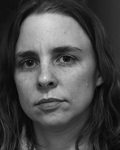2022
Solveig C. Nelson

Dissertation Abstract
"The Whole World is (Still) Watching: the Televisual, Early Video Art, Nonviolent Direct Action, 1940s-1970s"
Art historians have positioned video as a rupture initiated by the commercial release of the Sony Portapak in l967. As the story goes, artists in their studios turned the black and white portable video camera directly on their own bodies—a move that has been interpreted influentially by Rosalind Krauss in 1976 as a shoring up of the borders of self, a form of narcissism. Alternatively, video has been interpreted as a social process enabled by the camera's capacity for playback. Artists such as Paul Ryan in the late 1960s positioned video as the possibility to take in our own outsides in the presence of others. Challenges to Krauss's narrative such as David Joselit in his influential 2007 account of early video, Feedback: Television Against Democracy, have foregrounded Ryan's early reading and positioned video art as a democratic challenge against television.
Replacing ‘narcissism' with the concept of ‘feedback' in the Portapak narrative, Joselit and subsequent scholars have utilized the technical process in which an output is re-introduced as an input, initially developed in telecommunications as a method of reducing interference in an electronic signal, for a powerful metaphor for socially-engaged critique. However, even the social reading of video's primal scene requires an account of how precisely the capacities of video as a medium were mapped onto politics. This requires a less tidy account of the relation between video and television than a positioning of video as countercultural challenge. I argue that artists and critics re-conceptualized television in the 1960s, from a mode of transmission for art ("art on television") to a site of possibility for artists ("artists' television"). This expansion of the role of artist came into synchronicity with the performative strategies of the civil rights movement. As nonviolent direct action became a popular movement, "direct" bodily interventions were re-conceptualized as televisual events. Such a confluence of factors puts the art movements of the 1960s precisely in the context of civil rights, rather than in its wake. I demonstrate that in order to understand video, we must look beyond, before, and behind what looks most like “video art.”
Art historians have positioned video as a rupture initiated by the commercial release of the Sony Portapak in l967. As the story goes, artists in their studios turned the black and white portable video camera directly on their own bodies—a move that has been interpreted influentially by Rosalind Krauss in 1976 as a shoring up of the borders of self, a form of narcissism. Alternatively, video has been interpreted as a social process enabled by the camera's capacity for playback. Artists such as Paul Ryan in the late 1960s positioned video as the possibility to take in our own outsides in the presence of others. Challenges to Krauss's narrative such as David Joselit in his influential 2007 account of early video, Feedback: Television Against Democracy, have foregrounded Ryan's early reading and positioned video art as a democratic challenge against television.
Replacing ‘narcissism' with the concept of ‘feedback' in the Portapak narrative, Joselit and subsequent scholars have utilized the technical process in which an output is re-introduced as an input, initially developed in telecommunications as a method of reducing interference in an electronic signal, for a powerful metaphor for socially-engaged critique. However, even the social reading of video's primal scene requires an account of how precisely the capacities of video as a medium were mapped onto politics. This requires a less tidy account of the relation between video and television than a positioning of video as countercultural challenge. I argue that artists and critics re-conceptualized television in the 1960s, from a mode of transmission for art ("art on television") to a site of possibility for artists ("artists' television"). This expansion of the role of artist came into synchronicity with the performative strategies of the civil rights movement. As nonviolent direct action became a popular movement, "direct" bodily interventions were re-conceptualized as televisual events. Such a confluence of factors puts the art movements of the 1960s precisely in the context of civil rights, rather than in its wake. I demonstrate that in order to understand video, we must look beyond, before, and behind what looks most like “video art.”

